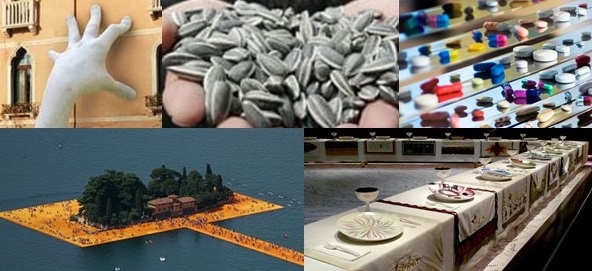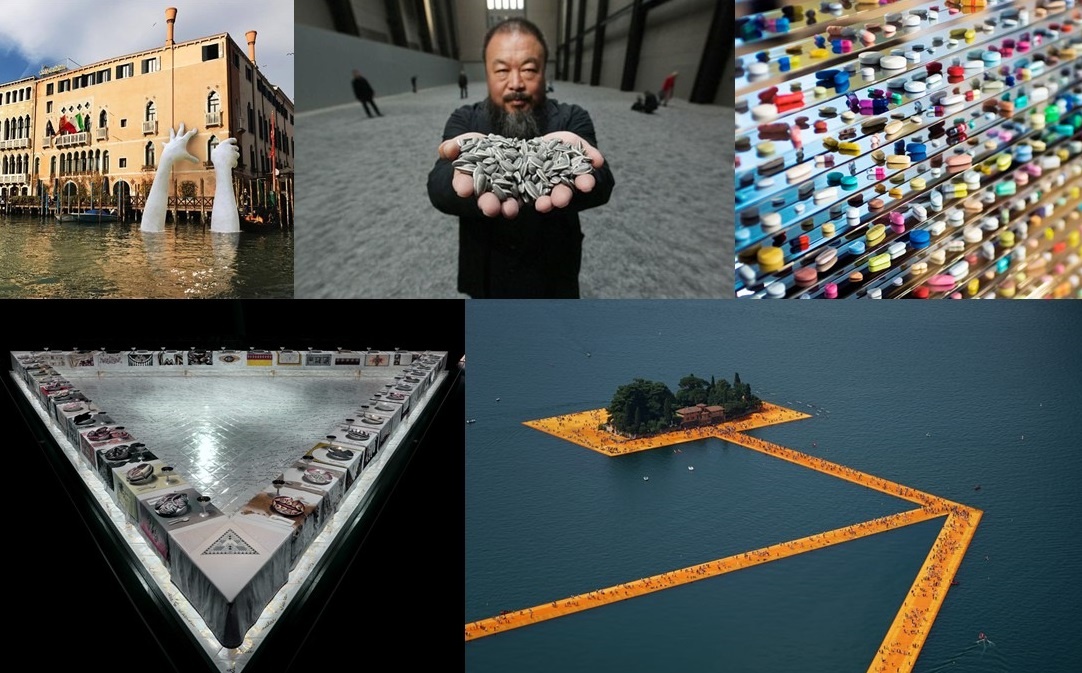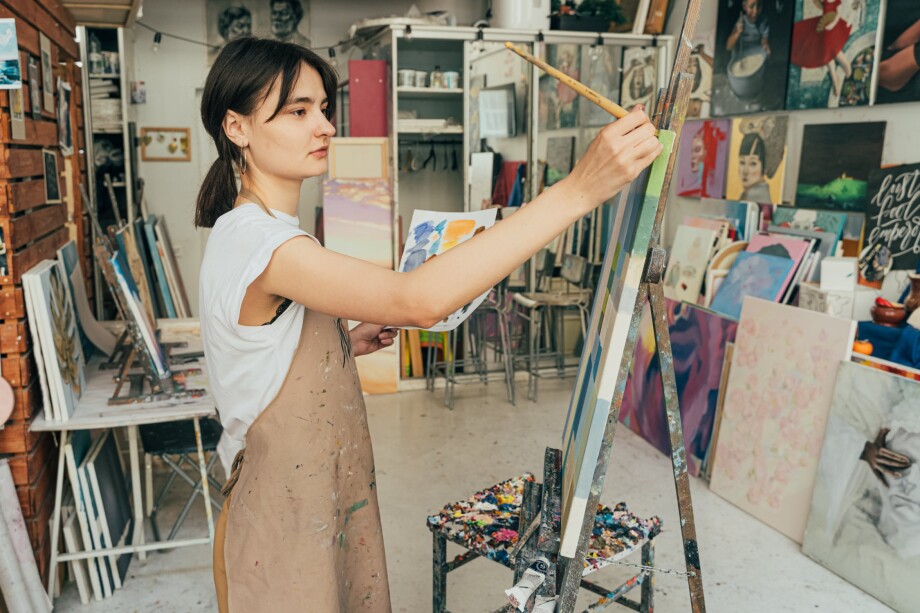Do your students understand modern art? Once my student, a 15-year-old girl, asked to talk about modern art. Her class visited an exhibition in Erarta, a museum of modern art in Saint-Petersburg, Russia, and she was so disappointed, irritated, angry at herself for not understanding that genre. As it’s impossible to squeeze everything about modern art into one lesson, I’ve chosen to start the ‘exploration’ with installations first.
Below I have collected ideas that you can choose, adapt to your students’ level and needs. Upon completion of this lesson, students will be able to explain what installation art is, name the most famous works, and create their work of modern art.
Task 1 — Warm-up
Start the lesson with a discussion of what modern art is. You can use some resources designed by The Museum of Modern Art (MoMA, New York), The Tate Modern (London), The San Francisco Museum of Modern Art (San Francisco, USA), and other museums.
Then let your students take a quiz and check if they can distinguish between modern art and children’s drawings.
Task 2 — Lead-in
Set the task:
Look at the zoomed pictures. What can you see? What type of art is it?

Keys:

Support by Lorenzo Quinn
Sunflower Seeds by Ai Weiwei
Lullaby Spring by Damien Hirst
The Dinner Party by Judy Chicago
Floating Piers by Christo and Jeanne-Claude
Task 3 — Installation Art: general information
In pairs, students brainstorm answers to the questions below.
- What is an installation? What are its key characteristics?
- What is the difference between sculpture and installation?
- When did this genre start?
- Who started installation art?
Then they read the text and check their guesses.
The emergence of installations as an artistic genre has changed the face of art. Involving objects in a space, installation art presents three-dimensional works that are often site-specific and designed to transform the perception of a space. Mostly temporary and large in scale, installation art draws the viewer in, engaging them in multiple ways and making them a part of the art. In this way, art becomes something you can touch, hear, feel or smell. Some people consider sculptures and installations similar. But, in fact, they can be viewed as an inverse of one another. Sculptures are designed to be viewed from the outside as a self-contained arrangement of forms whereas installations often envelop the viewer in the space of the work. Installations focus more on the arrangement, use of space, and surrounding environment within the artwork, artwork is seen as a whole together with the site the work is set in. Viewers are able to enter, move around, and interact with it in a way not possible with paintings and sculptures.
An art installation is actually a relatively new genre of contemporary art. In 1958, the artist Allan Kaprow spoke of the “environment” to describe his productions, which consisted of the creation of a room requiring the intervention or the situation of the spectator and the place in a sort of happening, later described as “performance.” Installation art came to prominence in around the 1970s. Many credits the start of this genre of art to Marcel Duchamp’s work, and Kurt Schwitters’ Merz art objects around this time.
Public installation art is an effective way of grabbing attention while imparting subversive social commentary. The element of interactivity keeps engagement with these artworks ongoing. Global awareness helps make public installations etched in viewers’ cultural memory of the cities they inhabit.
Keys:
- A three-dimensional works that are often site-specific, site-specific, large scale, and designed to transform the perception of a space.
- Sculptures are designed to be viewed from the outside as a self-contained arrangement of forms whereas installations often envelop the viewer in the space of the work. Installations focus more on the arrangement, use of space, and surrounding environment within the artwork, artwork is seen as a whole together with the site the work is set in. Viewers are able to enter, move around, and interact with it in a way not possible with paintings and sculptures.
- Allan Kaprow, Marcel Duchamp, Kurt Schwitters.
Alternatively, watch this video to get general information about installations:
Task 4 — Famous installations
Option 1: Famous installations of all time.
Ask your students to read the descriptions and match them with the works from task 2.

Support
Sunflower
Lullaby Spring
The Dinner Party
Floating Piers
An American artist, art educator, and writer, Judy Chicago is best known for her large collaborative art installation pieces which examine the role of women in history and culture. As one of the pioneers of the Feminist Art Movement in the 1970s, she called attention to women’s roles as artists and aimed to alter the conditions under which art was produced and received. As an attempt to redress women’s traditional underrepresentation in the visual arts, she placed the female subject in the center of her practice. Her most celebrated piece ____ from 1979 celebrated the achievements of women throughout history, featuring explicit vaginal imagery. She also employed “domestic” and “feminine” arts such as needlework and embroidery, introducing them to the world of high art.
Christo and his wife Jeanne-Claude enhanced the genre of land art, presenting a different approach to the environment and raising our expectations of it. Creating large-scale installations such as wrapping of the Reichstag in Berlin, Running Fence in Sonoma, and The Gates in New York City’s Central Park, they have repeatedly rejected all theories that their projects contain any kind of deeper meaning other than their immediate aesthetic impact. In 2016 Christo created the most ambitious project ever. ____ was a monumental installation in Italy that consisted of a 3 kilometers long runway that floats on water, allowing people to walk freely across it. What is incredible is how the artist empowered people to take this temporary street and making it theirs as if they were living a fantasy. When asked about their experience people responded things like: “It’s massive, it’s hard to describe, we’re so excited”, “It’s like walking on water. It’s wonderful”; others even said it felt like walking on the back of a whale
One of the most controversial figures associated with installation art is certainly Ai Weiwei. Expanding the definition of art to include new forms of social engagement, his dramatic actions highlight the widening gap between the ideal and the real in Chinese society. One of his most memorable pieces is the installation ____ . The ten-tonne work consisted of a staggering 100 million porcelain sunflower seeds, each one handmade and meticulously painted. Sunflower Seeds were designed to represent the people of China. On one hand, the identical seeds symbolize the uniformity imposed by the Chinese Communist Party, which discouraged any individuality that might destabilize its regime. On the other, the installation as a whole demonstrates the power of the masses, showing how together they can have a mighty impact. The sunflower seeds certainly made a splash at Sotheby’s in 2012, when 1 tonne of the tiny ceramic pieces was sold for an immense 2,500.
Known as one of the most discussed works on display in 2017, ____ gives Venice a ‘helping hand’ as many critics and fans have praised. The installation depicts two striking white hands that reach out from the Grand Canal to support the historic building of the Ca’ Sagredo Hotel. Quinn’s aim was to show the potential of human nature, the power that rests in our hands, and its lasting effect on the environment. People can help create or destroy the world around them, and Quinn hopes his piece inspires discussion on global warming and climate change.
____ is considered Hirst’s most expensive work for its value in dollars (2 million), It is a steel and glass cabinet holding 6,136 individually painted pills. Evoking the natural cycle of the passing seasons, ____ reminds us of the constancy of nature’s rebirth that has continued unabated for thousands of years.
Option 2: Best installations of ….
Choose a year and create a reading task with the descriptions of installations.
Best installations of 2020
Best installations of 2019
Best installations of 2018
Best installations of 2017
Best installations of 2016
Task 5 — Creating an installation
Watch the video about ways of creating installations:
Task 6 — Speaking about art
If you are preparing students for IELTS, here are the questions that you can use to talk about installation art:
Speaking, part 1:
Do you consider installation an art form?
What art form do you like best?
Speaking, part 2:
Describe a work of art that you really like. Tell:
What it looks like
Where you first saw it
Why you like it
Speaking, part 3:
How has art changed in the last few decades in your country?
Task 7 — New installations
Finish the lesson with a project. Ask your students to roll dice to choose the topic and create drafts with their installations. They should think over the design, size, materials, meaning, environment.
Installation: Lockdown madness
Installation: 2020
Installation: Perspectives
Installation: Together apart
Installation: Puzzle
Installation: Dreamland






 Вероника Аветисян
Вероника Аветисян 
 Маргарита Аветисян
Маргарита Аветисян 


